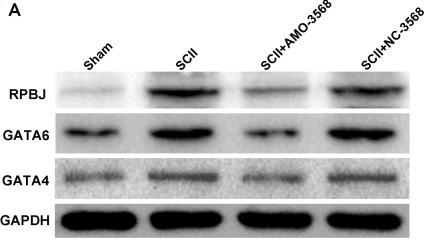GATA6 Antibody - #AF5270
| Product: | GATA6 Antibody |
| Catalog: | AF5270 |
| Description: | Rabbit polyclonal antibody to GATA6 |
| Application: | WB IF/ICC |
| Reactivity: | Human, Mouse, Rat |
| Prediction: | Pig, Zebrafish, Bovine, Sheep, Chicken, Xenopus |
| Mol.Wt.: | 45kD, 65kD; 60kD(Calculated). |
| Uniprot: | Q92908 |
| RRID: | AB_2837756 |
Related Downloads
Protocols
Product Info
*The optimal dilutions should be determined by the end user.
*Tips:
WB: For western blot detection of denatured protein samples. IHC: For immunohistochemical detection of paraffin sections (IHC-p) or frozen sections (IHC-f) of tissue samples. IF/ICC: For immunofluorescence detection of cell samples. ELISA(peptide): For ELISA detection of antigenic peptide.
Cite Format: Affinity Biosciences Cat# AF5270, RRID:AB_2837756.
Fold/Unfold
Gata binding factor 6; Gata binding protein 6; GATA-binding factor 6; Gata6; GATA6_HUMAN; Transcription factor Gata 6; Transcription factor GATA-6;
Immunogens
- Q92908 GATA6_HUMAN:
- Protein BLAST With
- NCBI/
- ExPASy/
- Uniprot
MALTDGGWCLPKRFGAAGADASDSRAFPAREPSTPPSPISSSSSSCSRGGERGPGGASNCGTPQLDTEAAAGPPARSLLLSSYASHPFGAPHGPSAPGVAGPGGNLSSWEDLLLFTDLDQAATASKLLWSSRGAKLSPFAPEQPEEMYQTLAALSSQGPAAYDGAPGGFVHSAAAAAAAAAAASSPVYVPTTRVGSMLPGLPYHLQGSGSGPANHAGGAGAHPGWPQASADSPPYGSGGGAAGGGAAGPGGAGSAAAHVSARFPYSPSPPMANGAAREPGGYAAAGSGGAGGVSGGGSSLAAMGGREPQYSSLSAARPLNGTYHHHHHHHHHHPSPYSPYVGAPLTPAWPAGPFETPVLHSLQSRAGAPLPVPRGPSADLLEDLSESRECVNCGSIQTPLWRRDGTGHYLCNACGLYSKMNGLSRPLIKPQKRVPSSRRLGLSCANCHTTTTTLWRRNAEGEPVCNACGLYMKLHGVPRPLAMKKEGIQTRKRKPKNINKSKTCSGNSNNSIPMTPTSTSSNSDDCSKNTSPTTQPTASGAGAPVMTGAGESTNPENSELKYSGQDGLYIGVSLASPAEVTSSVRPDSWCALALA
Predictions
Score>80(red) has high confidence and is suggested to be used for WB detection. *The prediction model is mainly based on the alignment of immunogen sequences, the results are for reference only, not as the basis of quality assurance.
High(score>80) Medium(80>score>50) Low(score<50) No confidence
PTMs - Q92908 As Substrate
| Site | PTM Type | Enzyme | Source |
|---|---|---|---|
| T34 | Phosphorylation | Uniprot | |
| S37 | Phosphorylation | P49840 (GSK3A) | Uniprot |
| S40 | Phosphorylation | Uniprot | |
| Y188 | Phosphorylation | Uniprot | |
| S266 | Phosphorylation | P28482 (MAPK1) , P27361 (MAPK3) | Uniprot |
| S268 | Phosphorylation | Uniprot | |
| Y282 | Phosphorylation | Uniprot | |
| R374 | Methylation | Uniprot | |
| S377 | Phosphorylation | Uniprot | |
| S436 | Phosphorylation | Uniprot | |
| S437 | Phosphorylation | Uniprot | |
| K484 | Sumoylation | Uniprot | |
| T515 | Phosphorylation | Uniprot | |
| S523 | Phosphorylation | Uniprot | |
| T534 | Phosphorylation | Uniprot |
Research Backgrounds
Transcriptional activator. Regulates SEMA3C and PLXNA2. Involved in gene regulation specifically in the gastric epithelium. May regulate genes that protect epithelial cells from bacterial infection. Involved in bone morphogenetic protein (BMP)-mediated cardiac-specific gene expression (By similarity). Binds to BMP response element (BMPRE) DNA sequences within cardiac activating regions (By similarity).
Nucleus.
Expressed in heart, gut and gut-derived tissues.
Interacts with LMCD1.
The GATA-type zinc fingers mediate interaction with LMCD1.
References
Application: WB Species: Rat Sample: spinal cord tissues
Restrictive clause
Affinity Biosciences tests all products strictly. Citations are provided as a resource for additional applications that have not been validated by Affinity Biosciences. Please choose the appropriate format for each application and consult Materials and Methods sections for additional details about the use of any product in these publications.
For Research Use Only.
Not for use in diagnostic or therapeutic procedures. Not for resale. Not for distribution without written consent. Affinity Biosciences will not be held responsible for patent infringement or other violations that may occur with the use of our products. Affinity Biosciences, Affinity Biosciences Logo and all other trademarks are the property of Affinity Biosciences LTD.


